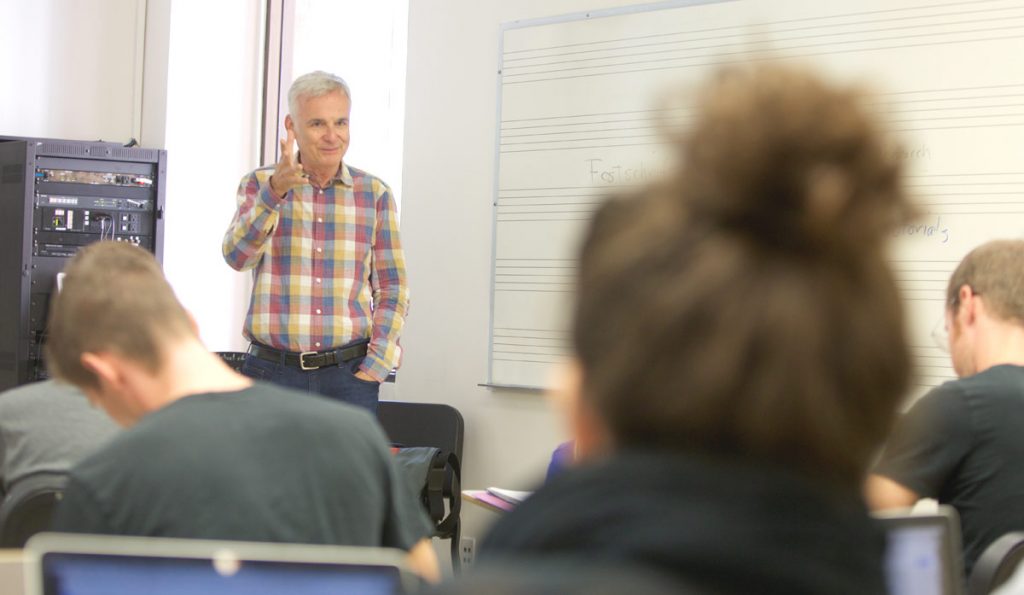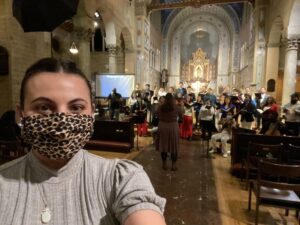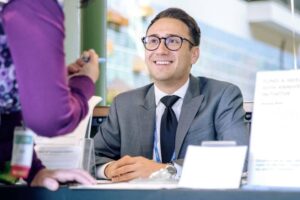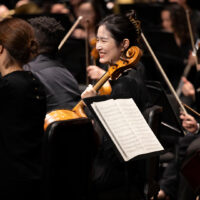
Building the Next Generation of Leaders in the Arts
By Tyler Francischine

The arts leadership masters degree is a customized experience aimed to help students realize their dreams.
When Jasmine Khorsandi (MS ’21) was a student enrolled in the USC Arts Leadership master’s program, she created a diversity and leadership workshop for Tonality, an award-winning vocal ensemble that presents concerts on themes of social justice and community activism. Just a few months after graduating from the program, she was invited to serve as managing director and executive administrator for the choir, where she worked side by side with its founder and artistic director, Thornton alum Alexander Lloyd Blake (DMA ’19), to manage the ensemble’s rapidly growing opportunities in Los Angeles and beyond in 2021.
The arts leadership program, created by Thornton professor and nationally renowned arts leader Kenneth Foster in 2013, takes only a handful of students each year – students who have focused, passionate goals for their future careers in the arts – and ushers them through the training necessary to first recognize the potential social impact the arts can have in communities, and then fine-tune their own ideas and see them through to fruition. For highly motivated students, the result is a wealth of knowledge paired with a network of connections that will aid them in either landing coveted positions in renowned arts institutions or creating their own institutions and havens for the arts themselves.
“I chose the arts leadership program because I saw that it provided the unique skills and space for leadership discussions that need to happen in the arts,” Khorsandi says. “I quickly learned that this program is unlike any other in the nation and would allow me to pursue my personal goals of making the arts relevant, accessible and approachable for all.”
Actualizing Dreams

Foster – whose more than three decades’ experience as an arts administrator, curator, educator and performing arts presenter includes many years as the executive director of San Francisco’s Yerba Buena Center for the Arts, an internationally recognized destination for contemporary art, performance and social activism – says he designed the Arts Leadership program to help students “actualize their dreams.”
“I’m trying to upset the paradigm that’s very common in the arts, which is ‘I am dependent on someone else to create a job for me. Then, I compete against other people like me for this job.’ I want them to create their opportunities,” Foster says.

With a fully customizable curriculum, the arts leadership program prioritizes individualized and interdisciplinary learning, encouraging students to take elective classes from several of USC’s colleges to best suit their long-term goals. A capstone practicum course pairs theory and practice, allowing students opportunities for guidance from both their peers and faculty on long-term projects of their choice.
“Students share their projects with each other, bringing in specific challenges for their peers to provide suggestions and advice,” Foster says. “The students have close relationships with faculty as well, who are all working professionals in the L.A. arts world and have the opportunity to connect students with the resources and real-world experience they need.”
Arts leadership program alum Jonathan Rios (MS ’21) says there’s one lesson he learned during his training that still guides his career today. After serving as a development associate and executive liaison for the Los Angeles Chamber Orchestra, Rios returns to Thornton this month as the director of major gifts and parent giving with the USC Thornton Office of Advancement.
“On day one, we learned environmental scanning: the process of looking through multiple lenses and types of ecosystems, whether that be politics, the natural environment or larger-scale issues within society. We see trends that can be brought into what we are doing in the arts. It promotes flexible organization-building,” Rios says. “Arts organizations can tend to exist in a vacuum where the organizations don’t think about what’s happening beyond their stages. Ken [Foster] has a philosophy: what happens on our stages should reflect what’s happening outside. The arts are a wonderful place for dialogue and community-building, and none of that can happen without environmental scanning.”
Looking Beyond the Stage
Foster says the program aims to teach students the keys to building sustainable organizations that reflect the communities they serve.
“The world we’re entering into is a complicated, constantly changing world. So, the patterns of how you’re supposed to do things are similarly shifting. Any prescriptions on how you run an arts organization are becoming irrelevant. A sustainable organization has the ability to adapt to change. There isn’t a fixed pathway,” Foster says.
During his arts leadership training, Rios created programming aimed at creating networking and education opportunities for emerging professionals intended for use by the Association of California Symphony Orchestras. As a direct result of his work, Rios was invited to be on the association’s board of directors, a formal recognition of his commitment to cultivating the next generation of arts leaders.
“I use my arts leadership training on a daily basis. The program gave me the rudimentary tools for doing what I do competently and also set a foundation for critically thinking about what I do every day,” Rios says. “Having the ability to analyze every level of not just what my arts organization is doing but what others are doing stems from that philosophy of environmental scanning. Having that lens really guides my experience.”
Putting Training into Practice

Khorsandi agrees that her arts leadership training aided her in landing jobs after graduation that fuel her creativity and passion. Recently, Khorsandi started a new position as a digital associate with New Music USA, a New York-based arts non-profit organization whose mission is to “support and amplify the sounds of tomorrow by nurturing the creation, performance and appreciation of new music for adventurous listeners in the United States and beyond.”
“The arts leadership program helped me reach where I am today because it challenged me to think bigger and take on the issues that are immediately impacting communities around me,” she says. “Our classes addressed such a wide range of topics that I previously may have not associated with the arts, to be honest. I now know that arts leaders have a responsibility to directly respond to the issues facing society today, which is the driving force behind the work I’ve committed to in the arts.”
Foster celebrates Khorsandi and Rios for their drive and focus, key ingredients of success that he says will aid any arts leadership student after they’ve graduated and joined the workforce in Los Angeles and beyond.
“They took advantage of every bit of this program they could,” Foster says. “They came in looking for tools they needed to advance their careers and lives, and they’ve been successful. They’re good examples of taking this program on. Just like for any artist, you have to really want it and go for it with this program.”
Read more about the USC Arts Leadership program
Arts Entrepreneurship: Where Art Meets StARTup
USC Thornton students learn to take an intelligent, innovative approach to the challenges and opportunities encountered as artists in the 21st century.
Kenneth Foster authors new book about arts leadership
Aron Forbes (BM ’07) works as a music director, Kenneth Foster, director of the USC Thornton Arts Leadership program, has authored a new book, Arts Leadership: Creating Sustainable Arts Organizations (Routledge), which focuses on building sustainable models for creative organizations amidst increasing political, economic, and cultural challenges.

